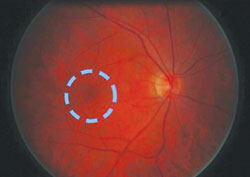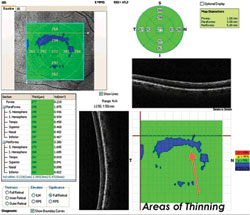Newer technology advised for screening patients taking hydroxychloroquine
Patients being treated with a certain antimalarial for rheumatic diseases should be screened for retinopathy according to updated guidelines in light of the sensitivity of new diagnostic techniques and a risk of toxicity that is higher than previously believed.
Hydroxychloroquine is used in the U.S. for treating inflammatory disorders such as systemic lupus erythematosus, rheumatoid arthritis, Sjögren’s syndrome and post-Lyme disease arthritis, according to a white paper issued by the Optometric Retina Society (ORS). The agent is commonly used outside the U.S. for treating malaria.
Corneal, retinal changes
“The possibility of retinotoxicity has always been an issue with the chloroquine drug class,” according to the ORS white paper. “The cornea may become affected by an innocuous vortex keratopathy characterized by whorl-like corneal epithelial deposits. These changes are relatively benign and bear no relationship to dosage and are usually reversible on cessation of hydroxychloroquine.
“The macular changes associated with toxicity are potentially serious and are related to dosage and duration,” according to the white paper.
 The circle indicates the expected zone of hydroxychloroquine toxicity. Images: Alexander L |
Larry J. Alexander, OD, FAAO, of McKinney, Texas, who wrote the ORS white paper on the revised guidelines, told Primary Care Optometry News, “Toxicity in the cornea is basically no big deal. It is not going to cause vision loss,” he said. “But toxicity in the retina is serious. It actually destroys tissue. The problem is that the drug never leaves the body. It starts accumulating in the retina. That toxicity causes a breakdown in the system.”
However, once a patient begins taking hydroxychloroquine, it typically takes 5 to 7 years “to build up to the point of losing vision,” Dr. Alexander said.
A cumulative effect of earlier toxicity may occur in patients with borderline liver function. And for patients who already have some type of retinal change, “you don’t want to start the drug in the first place,” Dr. Alexander said.
“The previous guidelines were observation, which is only going to catch the disease at the end phase; visual field testing, which does not catch the disease until the end phase; fundus photography, which does not catch the disease until the end phase; and color vision testing,” added Dr. Alexander. “The entire objective of the new guidelines is to detect toxicity before it causes too much damage, because even if you discontinue the drug, the damage still continues to occur. So the sooner you can detect the early phases of damage, the sooner you can discontinue the drug and hopefully hold the horse in the barn.”
Dosing issues
Adding to the problem is the fact that hydroxychloroquine is not necessarily being dosed properly, according to Dr. Alexander, “so you might build up toxicity quicker.”
Hence, he encourages optometrists to contact the prescribing practitioner to ensure proper dosing. “Most doctors are overdosing vs. underdosing,” he said.
The correct dosage is based on the ideal weight of the patient, not the patient’s actual weight, which is often many pounds in excess of ideal.
Screening schedule
The American Academy of Ophthalmology released new screening recommendations in the February 2011 edition of Ophthalmology. One new recommendation is that patients should schedule a baseline screening exam for retinal imaging within the first year of beginning hydroxychloroquine, rather than before starting the medication. Then, for low-risk patients, the first follow-up screening does not occur until 5 years out, followed by yearly screenings.
 The earliest sign of hydroxychloroquine toxicity becomes apparent. |
But for high-risk patients – anyone taking more than 400 mg/day of hydroxychloroquine as opposed to the typical dosage of between 250 mg/day and 400 mg/day, the elderly, patients with kidney or liver disease, or those with a pre-existing retinal condition such as age-related macular degeneration – the new recommendation is a yearly screening from the start.
By monitoring the patient closely, any changes can be relayed to the patient’s primary care physician or rheumatologist.
Screening technology
Previous tests such as Amsler grid and color vision are no longer considered acceptable screenings under the new guidelines. Now, a 10-2 automated visual field test is advocated, in conjunction with one of three newer objective tests: a multifocal electroretinogram (mfERG), spectral domain optical coherence tomography (SD-OCT) or fundus autofluorescence (FAF).
“Most of us will have the easiest access to a SD-OCT vs. FAF, whereas a mfERG is difficult to find even in large urban centers, even though it is probably the most reliable of the three tests,” Blair B. Lonsberry, MS, OD, MEd, FAAO, clinic director and professor of optometry at Pacific University College of Optometry in Portland, Ore., said in an interview.
The classical visual field defect that is observed in patients undergoing hydroxychloroquine toxicity occurs in the parafoveal region and results in paracentral scotomas.
“There are many instances where retinopathy was unrecognized for years because field changes were dismissed as ‘nonspecific’ until the damage was severe; therefore, the new guidelines stress that 10-2 visual field should always be repeated promptly when central or parafoveal changes are observed, to determine if they are repeatable,” Dr. Lonsberry said. “Advanced toxicity shows well-developed paracentral scotoma.”
Dr. Lonsberry feels it is important that optometrists review the literature and be aware of toxicity changes to the retinal layers, including a thinning of the outer nuclear band.
“SD-OCT can show localized thinning of the parafoveal retinal layers, thus confirming toxicity,” he said. “There is not enough detail with time-domain OCT; these retinal changes will be visible prior to visual field defects.”
In addition, FAF may be used to reveal subtle macular retinal pigment epithelial defects observable by an increase in FAF because the toxicity results in an increase in lipofuscin in the damaged cells.
Similarly, mfERG “can objectively document localized paracentral ERG depression in early retinopathy,” Dr. Lonsberry said. “It is important to recognize these early toxicity changes, as patients can experience continued toxicity damage months to years after cessation of the medication.”
Dr. Alexander agrees with Dr. Lonsberry that few practices have access to mfERG, while FAF is available on only two instruments.
As a paid consultant to Optovue, Dr. Alexander said that the company’s instruments test for ganglion cell complex (GCC), “which allows for the earliest phase of detection,” he said. “But you can still do a reasonable job with the other SD-OCT instruments.
“If you do not incorporate one of these three technologies [mfERG, SD-OCT or FAF], you really should not be seeing the patient,” he added. “You should send the patient to someone who does.”
The first sign of toxicity is thinning of the retina at about 1 mm from the fovea of the macular area (bull’s eye maculopathy). “This is a fairly new finding,” Dr. Alexander said.
Treatment is to stop the medication. “There are plenty of alternatives to hydroxychloroquine,” Dr. Alexander said. “But as with any drug, it should be monitored carefully.”
“Although the new guidelines indicate that the prevalence of hydroxychloroquine toxicity is probably slightly higher than previously thought, the incidence is still really low for toxicity build-up: approximately 1% of this population,” Dr. Lonsberry added. – by Bob Kronemyer
Reference:
- Marmor MF, Kellner U, Lai TY, et al. Revised recommendations on screening for chloroquine and hydroxychloroquine retinopathy. Ophthalmology. 2011;118(2):415-422.
- Larry J. Alexander, OD, FAAO, can be reached at 4500 Nightsbridge Dr., McKinney, TX 75070; (510) 396-3527; larryalexander@tx.rr.com.
- Blair B. Lonsberry, MS, OD, MEd, FAAO, can be reached at Pacific University College of Optometry, 511 SW 10th Ave., Suite 500, Portland, OR 97205; (503) 352-2510; blonsberry@pacificu.edu.
- Disclosures: Dr. Alexander is a paid consultant to Optovue Inc. Dr. Lonsberry has no relevant financial disclosures.

